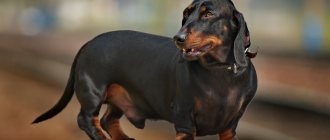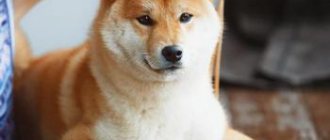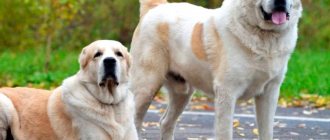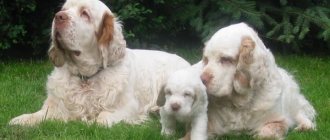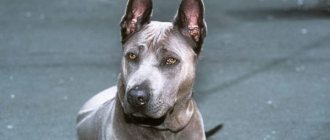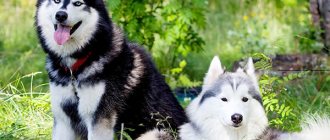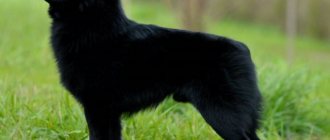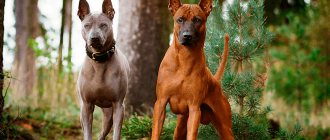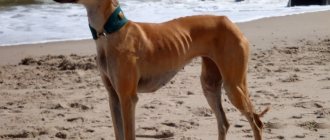The clumsy, funny, clumsy Shar Pei has a heart full of love for the family in which he lives, the makings of a psychologist and nanny, and in dangerous situations he will become a fearless defender.
Cute, unique, numerous folds of skin, varied coat colors and character traits make this dog one of the most popular in the world.
History of the Shar Pei breed
Shar Peis are sometimes also called "Han dogs." But not at all because they belonged to the great Mongol khans - the eventful history of China is usually divided into eras, and one of the longest is the Han Empire (206 BC - 220 AD). The earliest documentary evidence of the existence of this breed dates back to the reign of the Liu Dynasty. In the tombs of the 3rd century BC. e. archaeologists have found images of dogs with a square body, a curled tail and a frowning expression on their muzzle. It is believed that clay figurines of Shar Pei were designed to protect the deceased in the world of the dead.
Shar Pei
However, real representatives of the breed at the dawn of their existence were used mainly as participants in dog fights. There is reason to assume that then these animals were much larger, their weight reached 80 kilograms. The advantages in fights were also powerful jaws and prickly fur, which was unpleasant to grip, and the folds protected the most vulnerable places from significant damage: the muzzle and neck. They also became a good help when Shar-Peis began to be used for hunting large game that was ready to fight back against a pack - boars, wolves, big cats.
Its popularity has made the breed accessible not only to wealthy Chinese. Of course, during economic crises and famine, keeping dogs was an unaffordable luxury, but during periods of stability, peasants gladly used four-legged assistants to guard real estate and protect livestock from predators.
The first written mention of Shar-Peis that has survived to this day dates back to the 13th century, but the following centuries were not favorable for them - representatives of the Ming dynasty, through constant wars and strict demographic policies, forced their subjects to think not about breeding dogs, but about survival.
Shar Pei puppy
Interest in the breed arose again only in the 18th–19th centuries. But already in the 1940s, the rise to power of the communists led by Mao Zedong put the Shar Pei under the threat of complete extinction. From the point of view of the Communist Party, all domestic animals were a useless attribute of bourgeois life and were subject to extermination. Several individuals were preserved on the island of Taiwan and in the oldest European colony in East Asia - Macau. Transiting through Hong Kong, the first Shar Peis ended up in the United States in 1966, where they were registered under the name “Chinese fighting dog” in 1971.
At the same time, an article appeared in the press about a rare breed, with which a campaign to save Shar Peis started. Enthusiasts were forced to work with limited material, crossbreed with representatives of other, outwardly similar breeds, and resort to inbreeding. Han dogs were allowed to participate in national exhibitions in 1973. The first breed standard was approved three years later, after which official pedigrees began to be issued.
In the 80-90s, Shar Peis received recognition from many American and world cynological organizations: United Kennel Club, American Kennel Club, English Kennel Club, Federation Cynologique Internationale. In our latitudes, the first nurseries appeared after the collapse of the USSR.
Speaking about the latest news, it is worth noting the interest in Shar Peis from scientists. Geneticists from the University of Washington in Seattle carried out serious work and in 2010 announced that the cause of the formation of folds characteristic of the breed is a mutation of the HAS2 gene, which is responsible for the production of an enzyme fundamentally important for the formation of skin cells. They suggest that a spontaneous DNA glitch that resulted in the unusually “creased” puppy was noticed and fixed by ancient Chinese breeders.
Another study conducted in 2004 shows that the Shar Pei, along with the Siberian Husky, Afghan Hound, and Pekingese, belongs to the so-called first cluster of breeds, that is, their genotype is as similar as possible to the totality of wild wolf genes.
Weight
In accordance with the standard, the weight of adult dogs fluctuates in the following intervals:
- females - from 18 to 25 kg;
- males - from 25 to 30 kg.
Newborn puppies weigh about 500 grams, but after a month from birth their weight reaches 2.5 -3 kg. Further, Shar Peis increase their body weight every month and by the age of 12 months they almost completely reach their maximum weight (about 25 kg). But some young individuals can continue to grow for up to 15 months.
The weight of the dog must correspond to its size so that the animal looks harmonious.
Shar Pei appearance
Shar Pei Muzzle
The Shar Pei is a compact, stocky, square dog. Males are taller and more muscular, about 50 cm tall at the withers and weigh 23-25 kg, while females are on average 45 cm and 20-22 kg.
Head
Broad and flat, with a moderate stop between the crown and a broad, strong muzzle that does not taper towards the nose. The folds of skin around the forehead and eyes give the dog a frowning expression, even when he is relaxed.
Ears
The Shar Pei's ears are very small in relation to the dog's proportions, triangular in shape and folded forward.
Eyes
They are medium in size, almond shaped and vary in color depending on the color of the Shar Pei's coat.
Mouth
Large teeth, scissor bite. The jaws are powerful. The pigmentation of the gums, lips and tongue is pronounced: they should be blue-black, although in some individuals they have a lavender tint.
Neck and back
Folds on the back of a Shar Pei
Muscular and lean; Some excess skin around the neck is acceptable, although there should be no folds from ears to shoulders, possibly at the withers.
Frame
The ideal Shar Pei should be the same length from withers to buttocks as the height from ground to withers, with a chest half as deep as this measure, giving pleasing proportion. The ribs are well arched.
Front and hind limbs
Exhibit a moderate angulation of the joints, giving a powerful, athletic appearance and clearly muscular appearance. Skin folds are undesirable.
Tail
The Shar Pei's tail is thick at the base, where wrinkles are again often visible, and tapers to a thin tip. Can be twisted into a tight ring.
Shar Pei paw
Shar Pei tail
Wool
Consists only of guard hairs, there is no soft undercoat. Short and extremely rough, resembling stubble to the touch.
Color
Shar Pei can be any solid color except white: “red deer” (red, classic), black, chocolate, apricot or cream dilut, blue, Isabella, lavender and others. Spots are not allowed, but darker (along the spine and on the ears) and lighter (tail and back of the thighs) areas of the coat are possible.
Color
According to the standard, Shar Peis can be any solid color. Initially, the color palette was not very wide, but in 2005 changes were made to the registry and a complete list of colors characteristic of this breed was established.
All colors are divided into 3 groups:
- Group A - basic colors. Animals are distinguished by the presence of darkening in the nose area. The tongue of such dogs is dark purple or blue, and the pads of their paws are also dark in color.
- Group B - dilute colors. They lack black pigmentation on their body. Skin, nose and claws are the same tone as the fur. The eyes and tongue are lighter shades than those of the Group A breed.
- Group C - non-standard colors (breeding).
Group A includes the following types of colors:
- cream - as close to white as possible, they have too pronounced pigmentation;
- red deer - characterized by a dark fawn or dark red coat color, with age their shade becomes brighter;
- red is the most common color, it can be from rich red to light red, the main distinguishing feature is the presence of red hair, which dogs with the red deer color do not have;
- sable - visually easy to identify by the presence of a gray coating on the Shar Pei’s body, partly it is observed on the paws and face;
- black - pure black color is rare, this group includes dark brown, olive and brown Shar-Peis;
- blue - the color can be from a delicate smoky gray to a dark ash shade;
- Isabella - obtained by crossing dogs of blue and red colors, the coat has a pinkish-cream color with a blue or gray tint.
Group B includes the following types of colors:
- cream dilut - the color does not differ from ordinary cream, but there is no dark pigment on the animal’s face;
- apricot dilut - light golden-red color, derived from deer;
- red dilute - any red coat color of an animal without pronounced dark pigmentation, a mask on the face may be present, but be chocolate color, not black or gray;
- chocolate dilut - the color varies from light shades to more saturated ones, the tongue is lavender, the nose and paws are brown;
- lilac - rare, can be from pink-chocolate to pink-blue or smoky;
- Isabella dilute is the rarest color, grayish-pink coat without dark pigment.
The group of non-standard colors includes representatives of the spotted and black-backed breed. The first type is characterized by spots of various colors on a white background, and the second type is characterized by a black color on the back and lighter side parts of the body.
Photo of an adult Shar Pei
Description of pets
American Shar-Peis are slightly shorter than Chinese ones, have more skin folds on their faces, and have a more rounded head. The American Kennel Club adopted the breed standard in 1979, and the FCI approved it in 1999.
Breed standard:
- the head is large, the skull is round in shape, slightly flattened on top, the forehead is wide, sloping, the stop is moderately pronounced;
- the muzzle is wide, not narrowing towards the nose;
- the bridge of the nose is straight, a slight convexity at the base is acceptable, the lobe is wide, the nostrils are open;
- the lips are fleshy, the palate, gums and tongue are black-blue, with possible small pink spots on a dark background;
- jaws are strong, scissor bite;
- the eyes are small, oval, set deep in the folds of the skin, the iris is dark;
- the ears are small, triangular, fit tightly to the skull, set high and wide, the tips slightly rounded;
- the neck is medium, muscular, cone-shaped;
- the back is short, muscular, a deflection between the withers and a shortened loin is possible;
- the tail is of medium length, set high, thick at the base, tapering towards the end;
- The limbs are strong, not too long, located parallel.
The coat can be of 2 types: brush - soft hairs no more than 1 cm in length, and horse - hard hairs, reaching a length of 0.5-1 cm.
Shar Pei character
Shar Peis will definitely disappoint people who dream of a cheerful and playful pet. These are independent, reserved and not particularly active “philosophers”. If the owner gives up in their upbringing, they will not hesitate to take advantage of the mistake in order to take a dominant position in the “pack” and dictate their terms to the household members. However, an experienced owner who is able to assert his authority without the use of physical force and shouting will, with the help of professional advice, raise a well-mannered and obedient dog.
Shar Pei with owner
The security functions assigned to the breed for many generations leave their mark on the character. The Shar Pei will be wary of strangers and, in general, everyone who is not part of a close social circle and may openly demonstrate unfriendly intentions.
Han dogs have never been known as good-natured nannies who patiently endure the unintentional rudeness of small children. Leaving them alone with unintelligent little ones is strictly not recommended. It is also worth remembering that due to its physiological characteristics, the Shar Pei’s field of vision is very limited; it perceives sudden movements as a potential threat and reacts accordingly.
Shar Peis usually do not get along well with other animals. He perceives dogs as opponents, and, due to instincts, treats other pets as prey. An exception may be cats if they grow up together.
However, do not rush to become disillusioned with the breed and give up on purchasing a puppy! Properly trained and socialized sharpeis are wonderful companions. They are calm, intelligent, noble, devoted to their family, and not prone to fuss and loud barking.
A gift for you!
What do boys and girls look like and how are they different?
Externally, Shar Pei males and females are not much different.
This breed does not even have any special differences in height and weight in male and female genders. And if you have not dealt with Shar Pei representatives, then you are unlikely to be able to determine at first glance who is standing in front of you - a boy or a girl? However, there are still differences.
Most often, females are more elongated than males, that is, their body shape is more rectangular than square..
Despite the fact that there is no division by height and weight, females are often still slightly smaller than males. This feature is difficult to catch with an inexperienced eye.
Also, if the dog has already given birth, then the bitch can be easily identified by her belly: after giving birth and feeding, the previous fit of the bottom becomes more blurred, and without special training it can even sag.
Males look leaner and more muscular than females . They also differ in character to some extent. Males are possessive, more independent and disobedient. Bitches are flexible, they are much softer and kinder than males.
Thus, there are still differences between a Shar Pei boy and a girl, although not noticeable at first glance.
Education and training
These pet hippos are independent and stubborn. During the training process, you will urgently need patience and firmness, since teaching commands actually becomes a clash of wills between the owner and the dog. If your pet does not respond to certain demands, the problem is not at all a lack of mutual understanding - he is not lacking in intelligence, but the desire to dominate a person leads to disobedience.
It is important from the first days of a puppy’s arrival in a new family to demonstrate your authority without aggression, clearly defining the boundaries of what is permitted. The main mistake at this stage may be indulging the desires of a “cute baby” that looks so much like a soft toy. Restoring discipline after you show weakness will be very, very difficult!
In addition to following standard commands, a mandatory part of learning “good manners” should be the ability to behave in the presence of strangers and other pets. Any unmotivated manifestations of aggression are unacceptable here, although you cannot demand from a Shar Pei unusual delight at the sight of any guest. The ideal option would be a restrained reaction.
Color variations
The new color registry adopted in 2005 included red, fawn, black , cream, sable and blue . As well as delute red, cream, apricot and chocolate shades.
In addition, all solid coat colors except white are considered acceptable.
Delute-colored Shar-Peis have a smoky or chocolate mask on their faces, while Isabella Delutes have a lilac mask.
Care and maintenance
Due to their rather calm and quiet nature, Shar Peis are well suited for apartment living. Moreover, it is preferable because short hair does not protect against low temperatures, and overheating has a bad effect on the health of the animal due to the structural features of the skin and respiratory tract.
These dogs do not require expensive professional grooming or frequent bathing. We note, however, that during bath procedures (once every 2-3 months, if nothing extraordinary happens), it is necessary to use special shampoos that do not cause irritation, and thoroughly dry with a hairdryer. In short-haired animals, even seasonal shedding goes almost unnoticed; it is enough to iron them once a week with a mitten purchased at a pet supply store for combing out the fur, while pets with “bear fur” need more thorough care twice a year using rubber brushes.
Shar Pei washing
What needs to be done regularly and diligently is to take care of your skin. Sweat and fat secretions, dirt, and food particles accumulate in its folds, which can lead to dermatitis. Attention should also be paid to the ears to avoid inflammatory processes in the concha and ear canal.
To maintain normal physical shape, a Shar Pei needs an hour of walks a day. The structure of the skull makes them similar to dogs of the brachycephalic type (bulldogs, boxers, pugs), so intense exercise such as jogging and obstacle courses is contraindicated due to breathing problems.
Feeding recommendations do not differ from the standard ones for all purebred animals. A high-quality premium or super-premium ready-made food, or a carefully formulated diet based on conventional foods that will provide balanced nutrients. The serving size is individual and depends on the age, size and physical activity of each animal. It is imperative to ensure round-the-clock access to fresh drinking water.
Keeping a Shar Pei at home
These pets are not difficult to keep. Despite this, there are some nuances that must be taken into account based on the breed characteristics of the dog. These are unique dogs, but they can pose a number of challenges when caring for them.
Care and hygiene
Since the dog's hair is short, caring for it is not difficult; it is enough to comb it once a week with a special brush. When the molting period begins, you will have to use a special mitten or furminator. This approach will allow you to get rid of hair in the house, and also deprive your pet of discomfort. The fact is that Shar-Pei's fur is quite hard and prickly, so it requires regular removal. Water procedures are optional, although a couple of times a year can be organized, although few of the individuals will be noticeably happy with water procedures.
Important to remember! Since the skin on certain parts of the body forms characteristic folds and dewlap, they also require special care. The folds on the face should always be wiped with a soft cloth after the dog drinks water. In addition, after eating, food remains in the folds, which also need to be removed. At the same time, you should not lubricate these places with ointments or sprinkle them with powders without consulting a veterinarian.
Naturally, you will have to take care of the cleanliness of your ears, for which you use cotton swabs. They are moistened in a special liquid, which is sold in veterinary pharmacies. Use cotton pads to clean the Shar Pei's eyes if dirt accumulates in their corners, as well as discharge from the eyes. If the dog has enough toys and the pet is given special treats, then additional teeth cleaning activities will not be necessary.
When a dog is walked, the claws wear down naturally if the dog walks on a hard surface. If this is not possible, then you can use a nail clipper. These dogs easily tolerate subzero temperatures, so they practically do not need additional clothing up to minus 20 degrees. If the temperature is lower, then a special overall will come in handy. It is advisable to keep these dogs in a house or apartment, since they are not very adapted to long stays in the cold. A demi-season overalls, which will protect your pet from dirt and other external influences, will also not hurt.
What to feed
The difficulty is that it is very difficult to choose the right diet for this dog. This is due to the fact that many Shar Peis suffer from intolerance to certain foods. Experts recommend choosing super-premium or holistic ready-made food for these pets. At the same time, feed is gradually added to the main feed, observing the behavior of the animal.
The option of feeding natural food is possible, given the fact that a pet eats up to 1 kilogram of various foods per day. Half of the diet should be lean meat, offal, and fish. The second half of the diet is formed by porridges prepared with buckwheat, oatmeal and rice. In addition, your pet’s menu should include fermented milk products, as well as vegetables and herbs.
Important! After purchasing a puppy, the basis of the diet should be those products that were used by the breeder to feed it. The transition to a dog's diet that is more convenient for the owner should be carried out gradually.
As a rule, small puppies are fed up to 6 times a day. The frequency of feedings is gradually reduced to 2 times when the animal reaches 1 year of age. The diet is formed based on the dog’s individual preferences, while those foods that the animal refuses or eats reluctantly are excluded from the diet.
Diseases and breed defects
This breed, like many others bred artificially, is predisposed to a number of hereditary ailments, such as:
- Shar Pei fever.
- Seborrhea.
- Demodecosis.
- Dermatitis.
- Hypothyroidism.
- Food allergies.
- All kinds of tumors.
- Dysplasia.
- Tight lip syndrome.
- Turning of the eyelids.
- Otitis.
It is important to know! If you successfully select a puppy and then provide it with comfortable living conditions, then a number of health problems for your pet can be avoided.
Breed defects
These problems include:
- Pink tongue and palate.
- Erect ears.
- Tail too short.
- Any body color, as long as it is not solid.
Training and education
Once born, Shar-Peis are characterized by autonomy and independence, so they need to be properly raised and socialized from an early age. These animals do not allow themselves to be treated with disrespect, always acting evilly towards their owner. Therefore, the process of education and training should not be accompanied by shouting and violence. Persuasion and affection are the main components that will help you get a positive result in raising such a pet. Only in this case will the dog make contact, understanding what his owner wants from him.
It is important to know! You should not allow the slightest signs of aggression, either towards the owner or towards members of the household, immediately stopping such behavior of the animal.
These dogs are capable of showing unmotivated aggression towards other dogs or animals. In this regard, walks with a Shar Pei should be carried out exclusively on a leash. To prevent an animal from showing aggression towards its own kind, this should be taken care of from an early age, accustoming the pet to the company of other dogs and other animals.
Correctly and competently organized processes of education and training always bring positive results. In this case, a loyal and devoted friend grows up for all family members, who does not show aggression towards strangers or other animals.
How to raise Shar-Peis
Shar Pei health and diseases
Cynologists classify Shar-Peis as breeds with poor health.
The number of possible hereditary and acquired diseases during life is such that some organizations even raise the question of the advisability of further breeding. The reason for this is largely the dishonesty of breeders who, in the wake of the surge in popularity of Han dogs in the 80-90s of the last century, pursued commercial gain to the detriment of the welfare of the animals. Today, breeders, in close cooperation with veterinarians, try to cut off genetically undesirable breed lines, but even in good nurseries, puppies are born with certain diseases.
- Shar Pei fever (also known as swollen hock syndrome) manifests itself in swelling of the hock joint or even two against the background of an unexplained increase in temperature to 39-42 ° C, accompanied by abdominal pain, vomiting, and diarrhea. Presumably it is hereditary, usually occurs at the age of 18 months and can bother the dog in the future. There is no effective treatment; during attacks, symptoms are dealt with by reducing fever and pain with medications.
- Hypothyroidism is a lack of thyroid hormones, which provokes the development of epilepsy, alopecia (hair loss), obesity, hyperpigmentation, pyoderma (purulent inflammation of the skin) and other dermatological problems, and in especially severe cases, lethargy. Treated with medications and diet.
- Elbow or hip dysplasia is a degenerative disease that results in a weak joint in a growing animal and can lead to arthritis and lameness.
- Demodicosis is the appearance of areas of red, flaky skin, hair loss, caused by infection with skin parasites. The tick can be transmitted from mother to puppies in the first days of life and does not manifest itself until a period of decreased immunity. Humans and other animals cannot become infected through contact with a dog.
- Pyoderma is a bacterial infection that causes accumulations of pus in the outer layers of the skin and near the hair follicles.
- Seborrhea is dermatitis in the form of flaking of keratinized skin, most often the result of allergic, infectious and parasitic diseases, problems with the immune system, endocrine system or metabolism.
- Cutaneous mucinosis - excessive production of mucin by epithelial cells leads to the formation of mucus-filled blisters, primarily considered a cosmetic problem, but sometimes the oropharynx is affected, which provokes breathing problems. Treated with corticosteroids.
- Patella dislocation (patella) is a congenital or acquired displacement of the kneecap relative to its normal position, which is episodic or permanent. In severe cases, it is almost impossible to straighten it into the femoral block, and the animal loses the ability to lean on the affected limb.
- Osteochondrosis is abnormal growth of cartilage in the bursa, causing painful stiffness of the joint.
- Gastric volvulus is a dangerous condition that is associated with distension of the stomach by air trapped as a result of too rapid absorption of a large volume of food. Leads to disruption of normal blood flow and a sharp decrease in pressure. Immediate veterinary assistance is required! Warning symptoms include restless behavior, bloating, excessive salivation, and ineffective gagging.
- Glaucoma is increased intraocular pressure, leading to optic nerve atrophy and vision loss.
- Entropion is an incorrect position of the eyelids, in which the free edge of the lower (less often the upper) eyelid turns toward the eyeball and constantly injures its surface, causing inflammation of the cornea and loss of vision.
Nutritional Features
American Shar-Peis can be fed both natural products and industrial food - the choice depends only on the dog owner.
Each of these types of nutrition has its own pros and cons .
Thus, with a natural diet, the owner can independently control the quality of the food consumed by the pet, and all nutrients are better absorbed because they are of natural origin.
However, such feeding requires certain knowledge and skills and a lot of time for cooking.
The natural menu must be designed so that it contains a maximum of 9-12% fats and at least 24% proteins..
With this type of diet, Shar Pei must be given lean meat, offal (maximum 40% of the daily meat intake), boiled sea fish, buckwheat, rice and oatmeal, seasonal vegetables and fruits.
CAREFULLY!
It is strictly forbidden to feed your dog hard cheese, legumes, corn grits, potatoes, cabbage, fatty meat, smoked meats, pickles, and tubular bones.
Additionally, it is necessary to give your pet vitamin and mineral complexes.
Industrial feeds are convenient because they have a balanced composition enriched with vitamins and minerals, but there is a risk of developing food allergies caused by one of the components of the coma, which will entail a complete change of diet.
To feed representatives of this breed, you must choose only high-quality products, for example, food from the brands Go, Happy Dog, Orijen, Canidae, Pro Plan, Hills, Royal Canin, Eukanuba.
How many times a day and in what portions
The number of feedings per day depends on the age of the dog:
- up to 3 months – 6 times;
- 3-4 months – 5 times;
- 4-7 months – 4 times;
- 7-12 months – 3 times;
- after 1 year – 2 times.
The daily food intake of an adult representative of the breed should be approximately 3.5% of his body weight.
How to choose a puppy
It is worth noting: newborn Shar-Peis do not have folds at all, but by the 6th week of life they accumulate so many of them that they become like the rubber man Bibendum - a recognizable symbol of one of the car tire manufacturers.
As dogs grow older, they seem to “grow” into too large a skin; only the head and scruff of the neck remain covered with large wrinkles. To understand how strongly the folds will be expressed in the future pet and what type of coat it is, you need to take a closer look at its parents. The baby’s health largely depends on them, so do not hesitate to ask the breeder for medical documents. At the time of purchase, the puppy itself must have notes in its veterinary passport indicating that it has received age-appropriate vaccinations.
An important indicator is the living conditions of the mother and puppies. A dark, cramped, unprotected from the wind, and especially dirty enclosure is not in favor of the breeder. Good nutrition in the womb and in the first months of life lays the foundation for life, be sure to pay attention to the contents of the bowls!
If the Shar Peis of the chosen nursery do not participate in exhibitions at all, this is an alarm bell - they have problems either with health and physical indicators, or with behavior. It is better to refuse to purchase a pet in such a place.
The main thing is that the puppy makes contact easily, is not afraid of people and does not show aggression, and is not suspiciously apathetic.
Smooth-haired and long-haired
Shar-Peis are divided into two types based on their coat type.:
- Horse . The fur of this animal is more like bristles - short and hard, without undercoat. Its length barely reaches 1 cm in most cases;
- Brush . These dogs have elastic spines. It is much softer than that of Horses, it grows thickly, but there is also no undercoat. Brushes' fur is 1-2.5 cm long.
Since Shar-Peis do not have an undercoat, grooming and trimming of this breed is not allowed, because it can be harmful to the animal's skin.
Shar Pei puppy photo
Basic moments
- The Shar Pei comes from China and is believed to have common roots with Tibetan Mastiffs and Chow Chows.
- Geneticists have found that the age of the breed can reach 3 thousand years.
- The unusual fur of the Shar Pei is a strong allergen, so before purchasing, all family members should closely communicate with the dog to identify a possible reaction of the body.
- Despite the “toy” appearance of puppies and adult animals, their character is not at all plush.
- The Shar Pei needs an experienced and strong owner who can maintain his authority in the eyes of the pet.
- The dog is not recommended for families with children, but gets along well with older children and teenagers.
- Caring for an animal will not bring excessive trouble.
- Does not require constant physical activity.
- Preferably kept at home.
- Early socialization (possibly with the help of a dog trainer) is necessary to avoid aggression towards other animals and strangers.
- Unfortunately, Shar Peis are not long-livers; the average life expectancy is 8-12 years.
Shar Pei is one of those breeds that is impossible not to notice at any dog show or just a walking area. The unusual shape of the head and, of course, signature folds set them apart from their relatives, and the picture is complemented by a blue-black tongue - among hundreds of modern breeds, only the Chow Chow can boast of this. But no less famous among breeders is their independent character.
How much does a Shar Pei cost?
The lowest price for Shar Peis is traditionally offered at bird markets and online sites with free advertisements.
Naturally, in this case you have no guarantees of the purity of the breed, the health of the dog or the stability of its psyche. Pet-class puppies, that is, pets with purebred parents who do not fully meet the breed standard due to minor flaws in appearance and do not receive a formalized pedigree, cost from 12,000 rubles and more.
For breed-class Shar-Peis, which have all the characteristics of the breed and may be interesting for further breeding, new owners will have to pay at least 25,000 - 35,000 rubles.
The most expensive are show-class dogs; they not only fully meet the standard, but also have a character suitable for exhibitions and a special ability to present themselves. The potential of a champion cannot be determined at an early age, so if you hear categorical statements about such prospects in relation to a baby of 8-10 weeks, do not doubt the seller’s dishonesty. A real breeder knows that you can only ask for 50,000 - 65,000 rubles for a teenager (8-9 months) who already has experience participating in junior exhibitions.
Advantages and disadvantages
There is probably no ideal dog suitable for every person. American Shar-Peis also have negative and positive distinctive features, which you need to think carefully about before getting a dog of this breed.
Advantages
- A dog can and should be kept in an apartment.
- Pet cleanliness.
- An unobtrusive companion.
- Attractive appearance of the dog.
- Hassle-free care.
- No “dog” smell.
Flaws
- High likelihood of food allergies.
- Vulnerability to many diseases.
- The desire for dominance.
- Long walks are required.
- Parenting requires skill and experience.
- Problems are possible in relationships with young children.
Métis
To obtain mixed breeds, two different breeds of dogs are crossed. Shar Peis have many similar crosses.
Labrador mix
This kind of crossing is at the beginning of the journey and is quite rare. Externally, the dog resembles a Labrador, only with folds. Especially on the face. The color will be solid, the color may be different. The size turns out to be something average. Less Labrador, but more Shar Pei.
This mixed breed is resistant to genetic diseases. By nature, he is more likely to be a companion who gives love than a guard.
With a shepherd
This is a more popular crossbreed. With its body structure, short hair, and wide muzzle, the dog resembles a Chinese ancestor. Height is about fifty-two centimeters. But the color, like that of a shepherd, has a zonal pattern. Also, a shepherd dog can cause damage to its sickle-shaped tail and erect ears.
The dog is very smart and easy to train. But she is quite willful, so she needs a trainer with a strong character.
Caucasian, Central Asian and Eastern European breeds are not in great demand due to possible genetic problems.
With a pit bull
It is impossible to say for sure which parent the puppy will resemble. Genes are unpredictable. A mixed breed can grow tall, with a pitbull face, or vice versa, shorter than a Shar Pei. The coat color is varied: black, brindle, sand. But most dogs have a black mask on their face.
Their body is muscular and may have folds.
To prevent them from showing aggression, they need a strict person who will educate them.
With Stafford
This type of crossing is not very common due to genes. In childhood, the mixed breed looks like a Shar Pei due to the presence of folds. As an adult, he becomes similar to the Staffordshire Terrier. The height is about fifty centimeters, like the Shar Pei. Weight about 30 kg. In this way he is like a second parent.
. An experienced dog handler can help deal with this problem.
Varieties: description and photo
Dogs of this breed can be of several types. They have many similarities with each other, but there are also differences.
Chinese
Adult
Rare sable puppy
Young Chinese Shar Pei
The Chinese Shar Pei is a fighting breed of dog. The peculiarity of this breed is its wrinkled skin. The puppy has a large number of folds covering its entire body. An adult dog has such folds mainly on the face and neck. The first irregularities are observed on the third day after birth. By the age of one month, seven of them appear.
The color of the coat can be monochromatic or slightly diluted, darkening the face and back, and on the remaining parts it acquires a lighter shade. The coat is short, stiff, sometimes soft, lilac, blue, chocolate, fawn, red, cream, apricot or sable. The character is majestic, restrained. Shar Pei are good guards and do not harm children.
American
Adult American Shar Pei
American Shar Pei of interesting color Black puppy
The Shar Pei of this breed was revived by American cynologists, using single individuals of the ancient Chinese fighting dog as a basis.
Larger body size, long legs. The coat is coarse and short. Black color is a sign of the American variety. There are monochrome dogs. They are also loyal and affectionate to their owner. There is a mistrust of others, so proper training is needed.
